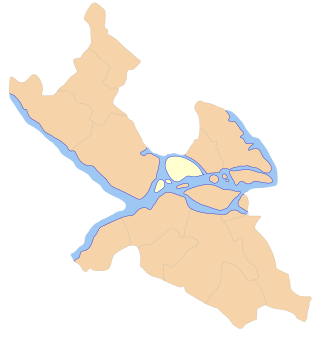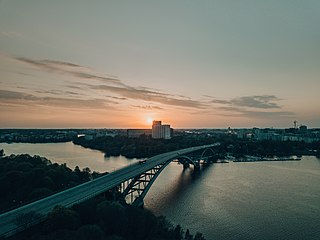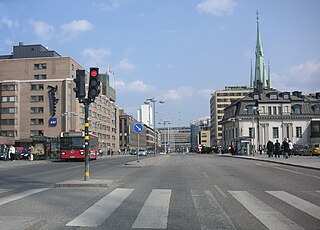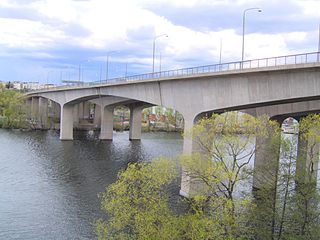
Sundbyberg Municipality is a municipality in Stockholm County in east central Sweden, just north of the capital Stockholm. Sundbyberg is wholly within the Stockholm urban area and has a 100% urban population.

The City of Stockholm is situated on fourteen islands and on the banks to the archipelago where Lake Mälaren meets the Baltic Sea. The city centre is virtually situated on the water.

Kungsholmen is a borough (stadsdelsområde) in central Stockholm, Sweden. It is named after the dominating district and island in the borough. Except Kungsholmen (proper) there are six districts in the borough: Fredhäll, Kristineberg, Lilla Essingen, Marieberg, Stadshagen and Stora Essingen. It is also equivalent to the parishes of Kungsholm, Sankt Göran and Essinge. The population as of 2004 is 54,283, of which 28,614 are female and 25,669 are male, on an area of 4.85 km², which gives a density of 10,977.73 per km².

Kungsholmen is an island in Lake Mälaren in Sweden, part of central Stockholm, Sweden. It is situated north of Riddarfjärden and considered part of the historical province Uppland. Its area is 3.9 km2 (1.5 sq mi) with a perimeter of 8.9 km (5.5 mi). The highest point is at Stadshagsplan at 47 metres (154 ft). The total population is 71,542.

The Stockholm congestion tax, also referred to as the Stockholm congestion charge, is a congestion pricing system implemented as a tax levied on most vehicles entering and exiting central Stockholm, Sweden. The congestion tax was implemented on a permanent basis on August 1, 2007, after a seven-month trial period between January 3, 2006 and July 31, 2006. It was inspired by Singapore's Electronic Road Pricing (ERP) system, which first introduced it in 1975.

Essingeleden is a motorway that goes from Solna to Stockholm, Sweden, crossing the westmost parts of central Stockholm, by going over Kungsholmen, Lilla Essingen, and Stora Essingen. Essingeleden has three bridges – Fredhällsbron, Essingebron, and Gröndalsbron – and one tunnel, Fredhällstunneln, which is one of the busiest tunnels in Europe. The road is part of European route E4 and E20, and is the busiest road in Sweden, with about 150,000 vehicles per day. In August 2007 this has increased to 170,000 cars per day, because Essingeleden was then the only road through central Stockholm exempt from the Stockholm congestion tax, and because of repairs of the main road through the inner city. This has caused big traffic jams on Essingeleden and Södra länken. Since 1 January 2016, Essingeleden has been subject to the congestion tax.

Västerbron is an arch bridge in central Stockholm, Sweden. With a total length exceeding 600 m, 340 m of which stretches over water, it is one of the major bridges in Stockholm, offering one of the most panoramic views of the central part of the city centering on Gamla stan, the old town. Its inauguration on 20 November 1935 made it the second stationary connection between the southern and northern parts of the city, saving the citizens the effort of a ferry ride, which had previously been required, or the congested detour through Gamla stan.

Klarabergsviadukten is a reinforced concrete bridge and an overpass in central Stockholm, Sweden. Stretching over Klara Sjö, it connects Norrmalm to Kungsholmen.

Mariebergsbron is a bridge in central Stockholm, Sweden. Formerly known as Lilla Essingebron, it connects the islands Kungsholmen to Lilla Essingen. The current name is due to the vicinity to the city district Marieberg.

Essingebron are two parallel bridges in central Stockholm, Sweden, inaugurated August 21, 1966, and September 3, 1967. Forming a section of the Essingeleden motorway they connect the two islands Stora Essingen and Lilla Essingen and are the most heavily trafficked bridges in Sweden. The current bridges replaced a bridge called Stora Essingebron inaugurated on May 10, 1965, as the motorway being built then resulted in a number of bridges connecting to Stora Essingen and the name was considered ambiguous.. The motorway bridges are paralleled by a bridge for local use, Gamla Essinge Broväg.

Fredhällsbron is a bridge in central Stockholm, Sweden. It connects the island Lilla Essingen to Fredhäll, a district on the island Kungsholmen, and, forming a section of the Essingeleden motorway, connects the Lilla Essingen interchange to the tunnel Fredhällstunneln.

Schönfeldts Gränd is an alley in Gamla stan, the old town in central Stockholm, Sweden. Stretching south-west from Stora Nygatan to Mälartorget it is crossed by Lilla Nygatan and Munkbrogatan, and forms a parallel street to Kåkbrinken and Lejonstedts Gränd.

Stora Essingen is an island and a district in the Kungsholmen borough in Stockholm, Sweden. It is located adjacent to Lilla Essingen on Lake Mälaren. Both Essingen Islands are mainly residential areas. Stora Essingen is scattered with private houses and apartment buildings. The Essingeleden motorway, part of European route E4, passes along a section of the eastern shore. The Tvärbanan light rail passes near the eastern shore and has one stop on the island.

Karlbergskanalen is a canal in western central Stockholm, Sweden.
Marieberg is a district located on the island of Kungsholmen in Stockholm City Centre, Sweden. Marieberg is part of the Borough of Kungsholmen. It is located west of Fridhemsgatan/Riddarfjärden, south of Drottningholmsvägen and east of Essingeleden/Viktor Rydbergs gata. In the south Marieberg borders the Mariebergsfjärden.

The Essingen Islands are a group of two islands—Stora Essingen and Lilla Essingen—in the Swedish lake of Mälaren, located southwest of Kungsholmen in Stockholm. Both Essingen islands are mainly residential areas, the smaller densely packed with apartment buildings while the larger is scattered with private houses and, to a lesser extent, apartment buildings.

The Angantyr is a Swedish motor vessel, and former steam ship, that was built in 1909 at Motala Verkstads Nya AB. She now operates cruises and charters for the Strömma Kanalbolaget and is a listed historic ship of Sweden.

The following outline is provided as an overview of and topical guide to Stockholm:
Stora Ursvik is a district in Sundbyberg Municipality with 2306 inhabitants, and a suburb in the Stockholm metropolitan area. An unbuilt corner of the district is located in Stockholm Municipality. This residential area is under construction, with an estimated completion in 2026. The first people moved in in 2007. Before that it was farmland owned by the Oxenstierna family, then from the beginning of the 20th century by the Swedish military until 2005. It is connected to Lilla Ursvik to the east and the uninhabited Kymlinge to the north. It is separated by motorways from Rinkeby to the west and Rissne to the south. Two tram stations, on the Tvärbanan Kista line, are planned in the west of the district. The building plan for the district has low buildings in the north and east, and higher buildings in the south and west.
Lilla Ursvik is a district in Sundbyberg Municipality with 1088 inhabitants, and a suburb in the Stockholm metropolitan area. It is located between Stora Ursvik to the west, Kymlinge to the north and Järvastaden to the east, with a motorway separating it from Hallonbergen to the south. Gustaf de Laval had a workshop here 1894-1899. The area was bought in 1906 by the Graham Brothers company, which build a factory here. Freestanding homes for workers were built around the same time.



















